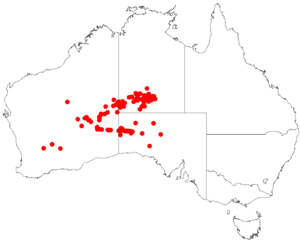Silky mintbush facts for kids
Quick facts for kids Silky mintbush |
|
|---|---|
| Scientific classification | |
| Genus: |
Prostanthera
|
| Species: |
sericea
|
 |
|
| Occurrence data from AVH | |
| Synonyms | |
|
|
The Prostanthera sericea, often called silky mintbush or walyuwalyu, is a type of flowering plant. It belongs to the Lamiaceae family, which includes mints. This plant is found only in inland Australia, meaning it's endemic to that area. It grows as an upright shrub with fuzzy branches, long, thin leaves, and pretty white flowers that have streaks of purple or mauve.
Contents
What the Silky Mintbush Looks Like
The silky mintbush is an upright shrub that usually grows about 1 to 2 meters tall. Its branches and leaves are covered in soft, silvery-green or grayish-green hairs, which gives it a silky look.
Leaves and Flowers
- The leaves are shaped like cylinders, sometimes with a small groove on the bottom. They are about 10 to 53 millimeters long and 0.5 to 3.5 millimeters wide. The leaves are sessile, which means they attach directly to the stem without a stalk.
- The flowers grow in groups of four to fourteen at the ends of the branches. Each flower sits on a short, hairy stalk called a pedicel, which is about 1.5 to 3 millimeters long.
- The sepals are like small, cream-colored leaves that protect the flower bud. They form a tube about 1.5 to 3.5 millimeters long. This tube has two parts, called lobes. The bottom lobe is about 1.2 to 2.8 millimeters long, and the top lobe is about 2 to 5.4 millimeters long.
- The petals are the colorful parts of the flower, about 7 to 10 millimeters long. They are white with pretty mauve or purple streaks inside the flower's tube.
- The flower's lower lip has a middle part that is shaped like a small spoon, about 3 to 5 millimeters long. The side parts of the lower lip are egg-shaped and about 2 to 4.5 millimeters long.
- The upper lip of the flower is also egg-shaped, about 1.5 to 5.5 millimeters long. It has a small notch in the middle, about 0.5 to 2.5 millimeters deep.
- You can usually see the silky mintbush flowering from July to December, or sometimes in March.
How the Silky Mintbush Got Its Name
The silky mintbush was first officially described in 1926 by a scientist named John McConnell Black. He gave it the name Prostanthera baxteri var. sericea. He wrote about it in his book, Flora of South Australia. The plants he studied were collected near the Birksgate Range during an important trip called the Elder expedition of 1891.
Later, in 1988, another scientist named Barry Conn decided that this plant was special enough to be its own species. So, he changed its name to Prostanthera sericea. He published this new name in a science journal called Nuytsia.
Where the Silky Mintbush Lives
The silky mintbush grows in different types of places in inland Australia. You can find it on stony hills, in rocky gorges, and on sand dunes and sandy plains. It lives in the eastern part of Western Australia, the southern part of the Northern Territory, and the western part of South Australia.

